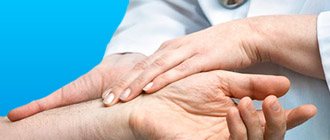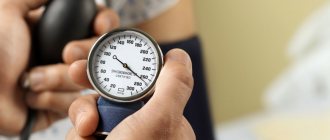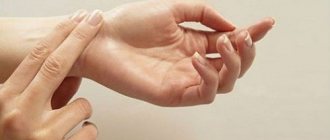In this article:
- What is pulse?
- Correct measurement algorithm
- How to measure pulse using a tonometer?
- How does a pulse oximeter work?
- Benefits of a heart rate monitor
- What can fitness bracelets do?
- Pros of using devices
- How to evaluate heart rate?
Pulse measurement is the easiest and most accessible way to assess the condition of the cardiovascular system. You can determine your indicator at home, while walking, or in any other circumstances. To calculate your heart rate manually, a regular watch with a stopwatch is sufficient, but you can also use modern gadgets that will determine and store the resulting value in memory.
How to calculate heartbeat and pulse manually without a heart rate monitor
You can count the pulse manually (without a heart rate monitor) on the wrist or carotid artery by palpation, that is, count the beats at the pulsation point, but to directly measure the heartbeat you need to find the apex beat. To do this you should:
- Lie down on the bed.
- Place the palm of your right hand under the left breast in women or under the left nipple in men.
- Find the place of the clearest heart beats.
- Start the stopwatch for 1 minute.
- Count all the beats of the apex of the heart.
Location of the apex beat
It is not always possible to easily measure the heartbeat by palpation in the left half of the chest. This is easier to do in people with a thin build or with increased force of contractions of the left ventricle (hypertension, heart disease). You can determine the heart rate much more accurately by listening to the heart with a phonendoscope.
What is pulse?
First, you need to define the basic concepts, figure out what and why you will measure. Not everyone knows that heart rate and pulse are not the same thing. The first indicator reflects the number of contractions of the ventricles of the heart per minute, i.e. how many times during this period the ventricles filled with blood and pushed it into the aorta and pulmonary artery. And the pulse is the number of vibrations in the walls of the arteries that occur due to contractions of the heart.
In a healthy person, these indicators are the same, but in some pathologies they may differ. The norm for an adult is a pulse rate of 60-90 vibrations per minute; in children, the indicator is determined by age. The younger the child, the faster his pulse. When measuring the pulse, the doctor determines several parameters:
- Frequency;
- Filling;
- Voltage;
- Height;
- Rhythm;
- Form.
By taking measurements yourself, you can only find out the frequency. But this indicator also allows you to evaluate the work of the heart, choose the right physical activity, and notice changes in time.
Correct pulse counting on the hand
Well, okay, we found it, felt the pulse and we need to count it. In medicine, the number of pulse waves per minute is considered the norm. Normally it ranges from 50 to 85 per minute. Thus, in order to determine whether our pulse is normal or not, it is necessary to count the number of vibrations of the vascular wall per minute. If you are in a hurry, then you can count in 30 seconds and multiply by 2. If you are in a hurry, then you can count in 15 seconds and multiply by 4. But a more reliable and accurate result is obtained if you count the pulse exactly per minute. Pulse is a value that can change over time. If a person experiences physical activity, it increases; if a person is at rest, the pulse slows down. The pulse also changes depending on the emotional state of a person, so when excited, the pulse becomes faster. During sleep, the pulse is lower. The pulse does not always reflect every contraction of the heart. Sometimes, for example, with extrasystole - an extraordinary contraction of the heart, a pulse wave is not formed.
Now you know what a pulse is and how to measure it correctly on your hand. I wish everyone a normal pulse!
Correct measurement algorithm
There is a simple heart rate measurement algorithm that can be used in any circumstances. The pulsation can be clearly felt on the wrist, and equally on both hands. For such a measurement, several conditions must be met:
- Place your wrist at heart level in the palm of your other hand;
- Feel the pulse on the palmar side along the edge where the thumb is located (on the side of the little finger the pulse is usually not audible, this is due to the location of the radial artery);
- Wrap your fingers around your wrist so that your index finger is closer to the wrist joint;
- Apply gentle pressure with your fingertips on the wrist in the direction of the radius.
In this case, the middle and index fingers should feel the pulse wave - rhythmic vibrations of the artery wall. It is necessary to note the time and count the number of beats per minute.
Alternatively, you can measure your pulse in your neck. To do this, you need to find the carotid artery: run your fingers from the back corner of the lower jaw down the neck. However, it is believed that determining the pulse on the hand is more comfortable, and its results are more accurate.
How regular running, swimming, cycling, skiing affect your resting heart rate
Regular endurance training in sports such as running, skiing, swimming, cycling leads to athletic adaptation of the body and especially the cardiovascular system.
When engaging in cyclic sports, the amount of fat in the body decreases, cholesterol levels decrease, and the proportion of so-called high-density lipoprotein cholesterol increases - along with it, the ability to resist cardiovascular diseases increases.
In addition, the volume of the heart and lungs increases, and the blood vessels dilate. Particularly interesting metamorphoses occur with the heart. Its density increases, the muscle walls become thicker. In athletes, during physical activity, the heart beats less often, but stronger, which is associated with the increased volume (or capacity) of the left ventricle of the heart. This makes it easier for the heart to pump blood throughout the body with each beat, which leads to a decrease in resting heart rate.
A heart that has undergone such changes during adaptation is called “sports”, and this is a normal phenomenon when getting used to physical activity. Interestingly, this condition was previously considered a pathology.
How to measure pulse using a tonometer?
You can use special instruments for measurements. There are several options to check your pulse and at the same time find out some other important indicators. One of them is a tonometer. Such a device records pulse and blood pressure, and modern models are capable of:
- Save results in memory;
- Compare indicators with the norm, identify deviations;
- Calculate average values for a certain period;
- Transfer information through applications to mobile devices or to a computer, where you can conduct a full analysis, including using graphs and diagrams.
To get accurate results, you need to take measurements correctly. Measurements are taken in a sitting position, the cuff on the arm should be at the level of the heart. It is important to calm down and comply with all the requirements listed in the instructions for the device.
Automatic blood pressure monitors inflate the cuff themselves and take measurements. The user can only estimate his pulse and pressure using the numbers on the display.
How does a pulse oximeter work?
Another modern pulse device is a pulse oximeter. Its functions are to determine saturation and count the heart rate (pulse rate). This is a medical device, before using it you need to understand the features of its use.
So, pulse oximeter – what is it and how does it work? The device is equipped with two light sources with different wavelengths and a photosensor that detects the reflection/absorption of light waves by various tissues. The light is partially reflected/absorbed when passing through soft tissues and blood, this makes it possible to determine saturation - the saturation of arterial blood with oxygen as a percentage. The normal rate varies from 95% to 100%; lower values indicate malfunctions in the functioning of the body systems.
To measure your pulse with this device, you need to attach the sensor to your fingertip, press the button and wait a few seconds. The display will show two indicators simultaneously: pulse and saturation. If the values are outside the normal range, a beep will sound.
Benefits of a heart rate monitor
Tonometers and pulse oximeters are medical devices and are convenient to use at home. But many convenient gadgets have been created for people who prefer an active lifestyle. There is even a special device for measuring pulse, which is called a pulsometer.
Basically, devices of this type look like a wristwatch and are used to assess the effectiveness of physical activity by measuring heart rate. In addition to counting your pulse, heart rate monitors perform many useful functions:
- Calculate the average heart rate;
- Determine the maximum values;
- Allows you to set up an individual training zone and notifies you when you go beyond it with an audible signal;
- Equipped with a countdown timer;
- Show date, time, day of the week;
- Works as a stopwatch and alarm clock;
- They are synchronized with special software to transfer data to a phone or computer, where the dynamics can be analyzed.
Many devices provide additional functions, for example, determining the height or number of laps while running, calculating energy consumption, recording the acceleration of the legs, and others. Some models are equipped with a chest belt. The main advantage of heart rate monitors is the most accurate pulse determination, comparable to ECG data.
Calculation formulas
There are formulas for calculating the maximum heart rate, which are based on the age and gender of a person, but one must understand that they give a certain error, since the value of the maximum heart rate depends on the individual characteristics of the body of a particular person, and not just on age and gender.
Formulas based on age
| Haskell-Fox formula (used since 1970) | Maximum heart rate = 220 – age |
| Laundery-Meshberger formula | Maximum heart rate = 206.3 – (0.711 x age) |
| Tanaka formula (derived in 2001, considered the most accurate) | Maximum heart rate = 208 – (0.7 x age) |
| Miller's formula | Maximum heart rate = 217 – (0.85 x age) |
| Roberges-Landwehr formula | Maximum heart rate = 205.8 – (0.685 x age) |
| Jackson's formula (developed in 2007) | Maximum heart rate = 206.9 – (0.67 x age) |
Formulas taking into account age and gender
| White's formula | men: Maximum heart rate = 202 – (0.55 x age) |
| women: Maximum heart rate = 216 – (1.09 x age) | |
| Ball State University Formula | men: Maximum heart rate = 214 – (0.8 x age) |
| women: Maximum heart rate = 209 – (0.9 x age) | |
| Martha Gulati Formula (published 2010) | women only: Maximum heart rate = 206 – (0.88 x age) |
| Astrand's formula | men: Maximum heart rate = 220 – age |
| women: Maximum heart rate = 226 – age |
What can fitness bracelets do?
One way to check your pulse and get a lot of other useful information is to use fitness bracelets.
The compact device is fixed on the wrist according to the same principle as a watch. It doesn’t interfere with work, walking, training, and it’s even comfortable to sleep with. All this time the device measures:
- Number of steps taken and distance in km;
- Duration of sports training;
- Achievement of set goals in %;
- Volume of calories burned;
- Duration and quality of sleep.
The range of options depends on the model. For example, some devices synchronize with a smartphone, inform about incoming calls and messages, and transfer the results of all measurements to a mobile device for subsequent analysis. All fitness bracelets function as watches and alarms.
High resting heart rate: what to do
When the resting pulse is elevated and this is not due to objective reasons (age, gender, etc.), you can try the following:
- Quickly calm down or cool down by drinking a glass of cool water and doing breathing exercises - for example, inhaling deeply for 5 seconds and exhaling for 3 minutes.
- If the increase in heart rate is associated with emotions, try the psychological method of “grounding.” You need to get up and walk around the room or on the street, concentrating on momentary sensations, such as your foot touching the ground, and on what you see around you.
- A high morning heart rate indicates under-recovery - you need to get better sleep and reduce stress.
- If your heart rate has dropped or risen due to overtraining, rest and change your training plan.
- A resting pulse that is too low may indicate bradycardia, while a resting pulse that is too high may indicate tachycardia. Only a doctor can recognize and solve these problems.
Read on topic: Running at low heart rate: how and why to train at low intensity
Pros of using devices
Such devices are very popular due to their many advantages:
- A person can always evaluate his physical activity and, if necessary, adjust it;
- Calorie counter helps you stay fit;
- Heart rate measurement is carried out in real time with high accuracy;
- The cost of the devices is quite affordable;
- The bracelets look stylish and elegant;
- The device combines many useful functions.
In addition, fitness bracelets are easy to use. With their help, it is convenient to monitor your pulse during training without being distracted by taking measurements. Just place your finger and wait a few seconds for the measurement result.
How to evaluate heart rate?
Self-monitoring your heart is quite easy, especially with heart rate bracelets and other smart devices. But it is also important to evaluate the results correctly. To do this, you should take into account several nuances:
- The normal pulse at rest is 60-80 beats per minute;
- For women, the rate is 5-10 beats higher;
- The pulse in a lying position is minimal, in a sitting position it increases by 4-6 beats, while standing - by 10-14 beats per minute;
- In winter, the rate may be lower than in summer;
- Throughout the day, the pulse changes from the slowest at night to the maximum at 18-20 hours, increasing at 8-12 hours and about 15 hours, but it all depends on the daily routine of a particular person;
- After eating hot food and drinks, the pulse quickens.
Heart rate is related to physical activity: the more intense it is, the higher the indicator will be. During active sports, the heart rate increases to 150 beats per minute. A level of 200 blows is considered critical; at this level, the load must be reduced. In athletes, the heart muscle is more trained, so the heart rate during exercise grows more slowly than in an ordinary person.
Before checking the pulse on your hand or assessing the performance of special devices, it is worth considering the factors that influence the heart rate. The pulse increases not only due to physical activity. This effect can be caused by stressful situations, overeating or severe hunger, drinking alcohol or smoking, and even massage.
A heart rate deviation of 10% or more from normal may be a cause for concern. For example, if you have a constant rate above 90 beats per minute under the age of 30, you should consult a cardiologist. A decrease to 50 beats or below may also indicate the development of pathological processes in the body. A drop to 40-35 beats indicates a real threat to life.
Pulse measurement allows you to monitor the condition of the body, obtain objective indicators of the functioning of the heart and blood vessels, and promptly identify deviations. You can determine the indicators yourself manually or using special devices that monitor the pulse automatically with high accuracy.
Under what circumstances is it not recommended to measure your pulse?
There are a number of circumstances where the results will be biased. Sometimes this happens during a consultation with a cardiologist if the patient is too excited, but there are other situations.
- You should not check your pulse within an hour after eating, taking medications, or especially drinking alcohol. A lot of processes take place in the body, and the heart works at an accelerated pace.
- Indicators will be biased when a person is thirsty or hungry.
- The heart rate is always elevated after physical activity or training.
- Another reason to refuse the procedure is a massage, visiting a sauna or going to the beach: under the influence of high temperatures you should not expect objective information.
- Doctors do not recommend women to do calculations during menstruation, when hormonal changes occur in the body.
The ability to measure your pulse will come in handy sooner or later, so take into account all the nuances and practice on yourself and your loved ones. It is advisable to develop the skill in yourself so that in a critical situation you do not remember the equipment, but quickly come to the rescue.











